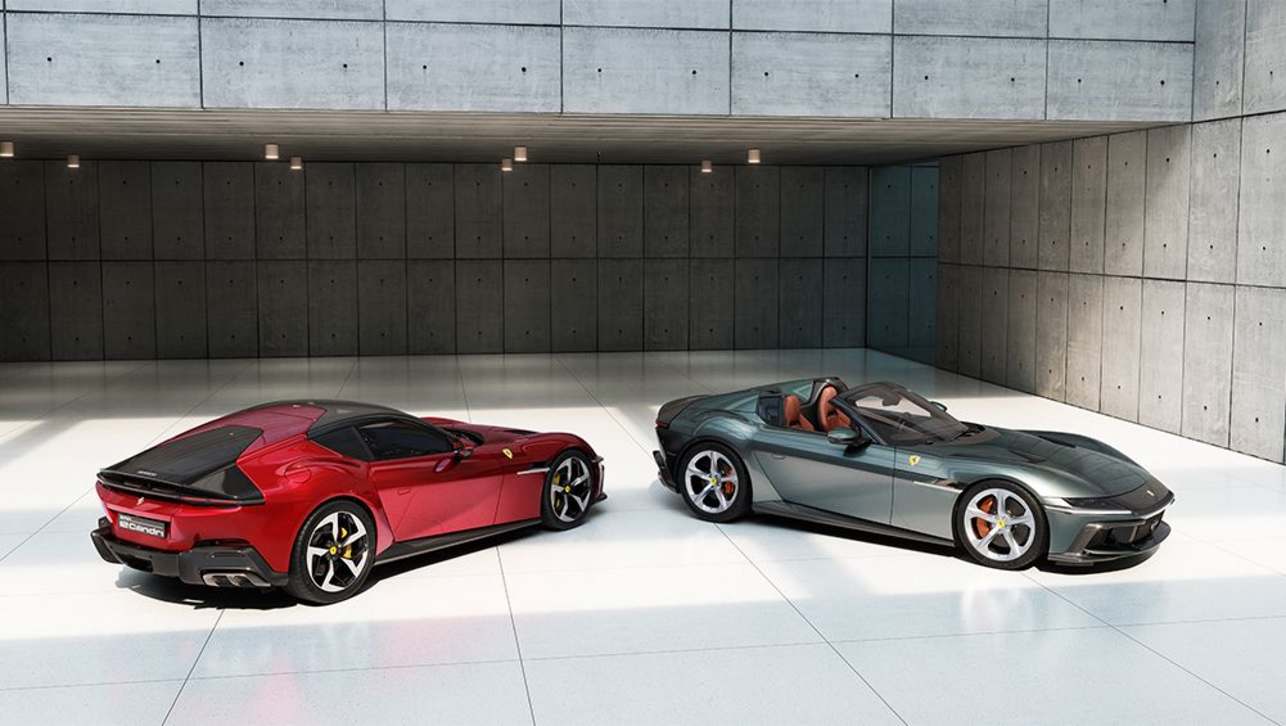Ferrari has unveiled the latest instalment in its front-engined V12 dynasty to replace the 812 GTS and Competizione. It’s offered in two-seat coupe – berlinetta in Italian – or spider forms.
Revealed in Florida to celebrate 70 years for the brand in the United States, the Flavio Manzoni-styled sports car is a grand tourer in the truest sense and draws on years of Ferrari tradition with nods to the 365 GTB/4, 599, 812 and more.
The name? It’s written 12Cilindri and pronounced “doh-dechi chillindri” which, to be fair, sounds gorgeous. It simply means 12 cylinders and will therefore join ‘LaFerrari’ as one of the Italian brand’s less imaginative names.
The sheer theatre of a 65-degree V12, which redlines at 9500rpm, should offset the dull name, for under its stretched front-hinged bonnet is the latest development of Ferrari’s 6496cc ‘Tipo F140HD’ V12.
It develops the same 610kW (at 9250rpm) as the 812 Competizione and while outright torque is down 14Nm at 678Nm, Ferrari promises to have worked on tractability with 80 per cent of that figure available from 2500 rpm.
The 12Cilindri's high rev ceiling has been achieved by using titanium connecting rods, new alloy for the aluminium pistons, a 3.0 per cent lighter crankshaft and F1-derived ‘diamond like carbon’ surfaces used in the sliding finger valvetrain.
Helping deliver the broad spread of torque is a shortened manifold with continuously variable intake geometry. An eight-speed dual-clutch auto transmission with five per cent shorter gear ratios further aids acceleration.

There’s also torque-by-gear tech for the atmospheric V12. Inspired by boost-by-gear tech in turbo cars, the ECU manages outputs and builds through the gear ratios. Ferrari specifically mentions the 'sculpting' of the torque curve in third and fourth gears.
The result is a front-engine rear-drive Ferrari that can get from rest to 100km/h in 2.9 seconds, hit 200km/h in less than 7.9 seconds and continue beyond 340km/h… and meet the latest European emissions requirements.
Sound is important, and Ferrari claims to have tweaked the V12’s intake resonators and exhaust resulting “in Ferrari’s typical V12 howl that comprises all of the noble combustion orders.” Colour us excited.
A brake-by-wire system with the 296 GTB’s 'ABS Evo' system and four-wheel steer feature. The latest iterations of 'Side Slip Control' and 'Virtual Short Wheelbase' are said to have better learning speed (10 per cent quicker) and provide enhanced grip on low-traction surfaces.

The 12Cilindri's chassis benefits from 15 per cent greater torsional rigidity than the 812 thanks to more cast parts, while cutting down on extruded components makes production more efficient. Ferrari has used 100 per cent recycled material in the shock towers of the transmission subframe.
Ferrari lists a weight distribution of 48.4:51.6 and a 1560kg dry weight. The spider is a mere 60kg heavier.
The 12Cilindri is longer (4733mm), wider (2176mm) and taller (1292mm) than the 812 Competizione though rides on a 20mm shorter (2700mm) wheelbase.
It also scores larger 21-inch alloy wheels which hide huge 398mm front brake discs. They’re shod in your choice of OEM-developed Michelin Pilot Sport S5 or Goodyear Eagle F1 Supersport tyres measuring 275/35ZR21 at the front and 315/35ZR21 at the rear.

Flavio Manzoni and the Ferrari Styling Centre design team wanted a radically new take on the Ferrari V12, moving away from the ‘sculptural’ language of the 812 for a more ‘sophisticated’ design.
Yet this is no aero-slave McLaren 750S or sharply-angled Lamborghini Revuelto, the 12Cilindri is distinctly Ferrari.
The nose’s black accent and lights situated beneath the crease conjure images of the 365 GTB/4 ‘Daytona’. It has an impossibly long bonnet with body work barely protruding above handsome wheels giving an extreme cab rearward design, further emphasised by the berlinetta's black glasshouse.
Ferrari says the front fenders were sculpted with "extreme geometric precision" and that the goal of the 12Cilindri “was to explore design languages only tangentially related to the car world”, noting the slit-like headlights and lack of traditional grille.

At the rear there’s no visible wing, instead two active flaps keep the 12Cilindri's "sensual" lines without sacrificing stability. There are two positions, high downforce and low drag, that the car can adopt.
The 12Cilindri’s underbody manages air flow to achieve high speed stability, cooling, downforce and aerodynamic efficiency. A flat surface draws air through to a functional rear diffuser where you find the signature quad tailpipe motif.
Inside, the 12Cilindri builds on the Purosangue’s design language adding a central 10.25-inch touchscreen to complement the 15.6-inch digital driver’s display and 8.8-inch passenger screen. Apple CarPlay and Android Auto are standard.

In the berlinetta, owners benefit from a glass roof while the spider’s disappears into the rear bulkhead meaning no rear bench for storage.
The 12Cilindri will eventually make its way to some very lucky Australian customers. They might have considered an Aston Martin DB12 or Lamborghini Revuelto while looking for the new car, or they might buy all three.
Pricing? Well, as they say, if you have to ask… The 812 GTS listed at $675,888 before on-road costs and options. With the Purosangue at $728,000, don’t expect much change from $800,000 if you rumble out of the showroom in a 12Cilindri berlinetta or spider.




-2.jpg)


.jpg)

.jpg)
.jpg)



.jpg)
.jpg)

.jpg)
.jpg)
.jpg)
.jpg)










.jpg)
Comments